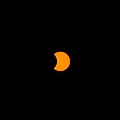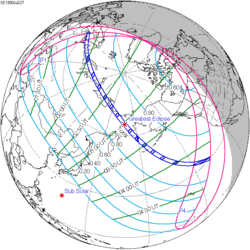Top Qs
Timeline
Chat
Perspective
Solar eclipse of May 10, 2013
21st-century annular solar eclipse From Wikipedia, the free encyclopedia
Remove ads
An annular solar eclipse occurred at the Moon's descending node of orbit between Thursday, May 9 and Friday, May 10, 2013,[1][2][3] with a magnitude of 0.9544. A solar eclipse occurs when the Moon passes between Earth and the Sun, thereby totally or partly obscuring the image of the Sun for a viewer on Earth. An annular solar eclipse occurs when the Moon's apparent diameter is smaller than the Sun's, blocking most of the Sun's light and causing the Sun to look like an annulus (ring). An annular eclipse appears as a partial eclipse over a region of the Earth thousands of kilometres wide. Occurring about 3.6 days before apogee (on May 13, 2013, at 14:30 UTC), the Moon's apparent diameter was smaller.[4]
Annularity was visible from parts of Western Australia, Northern Territory and Queensland, Australia, the Louisiade Archipelago (belonging to Papua New Guinea), the Solomon Islands, and Kiribati. All land within the path of annularity was west of the 180th meridian, except Tabuaeran in Kiribati. However, time zone of the Line Islands including Tabuaeran was changed from UTC−10 to UTC+14 in 1995, so annular eclipse visible from land was completely on May 10.
A partial eclipse was visible for parts of Indonesia, Australia, New Zealand, Oceania, and Hawaii. Part of these areas are west of the 180th meridian, seeing the eclipse on May 10, and the rest east of the 180th meridian, seeing the eclipse on May 9.
Remove ads
Visibility
Annularity was visible from a 171 to 225 kilometre-wide track that traversed Australia, eastern Papua New Guinea, the Solomon Islands, and the Gilbert Islands, with the maximum of 6 minutes 3 seconds visible from the Pacific Ocean east of French Polynesia.
Eclipse timing
Places experiencing annular eclipse
Places experiencing partial eclipse
Remove ads
Gallery
- Simulation of greatest annularity east of Marakei, Kiribati.
- Anthony Lagoon, Australia, 22:20 GMT (May 9)
- Partial from Manly Beach, New South Wales, 22:30 GMT (May 9)
- Partial from Docklands, Victoria, 22:49 GMT (May 9)
- Partial from Rockhampton, Queensland, 22:57 GMT (May 9)
- Bairiki, Kiribati, 0:15 GMT
- Eclipse shadows from a coconut leaf shadow. From Tarawa, Kiribati at 0:30 GMT
- Partial from Waikiki, Hawaii, 2:12 GMT
Eclipse details
Summarize
Perspective
Shown below are two tables displaying details about this particular solar eclipse. The first table outlines times at which the Moon's penumbra or umbra attains the specific parameter, and the second table describes various other parameters pertaining to this eclipse.[5]
Remove ads
Eclipse season
This eclipse is part of an eclipse season, a period, roughly every six months, when eclipses occur. Only two (or occasionally three) eclipse seasons occur each year, and each season lasts about 35 days and repeats just short of six months (173 days) later; thus two full eclipse seasons always occur each year. Either two or three eclipses happen each eclipse season. In the sequence below, each eclipse is separated by a fortnight. The first and last eclipse in this sequence is separated by one synodic month.
Remove ads
Related eclipses
Eclipses in 2013
- A partial lunar eclipse on April 25.
- An annular solar eclipse on May 10.
- A penumbral lunar eclipse on May 25.
- A penumbral lunar eclipse on October 18.
- A hybrid solar eclipse on November 3.
Metonic
- Preceded by: Solar eclipse of July 22, 2009
- Followed by: Solar eclipse of February 26, 2017
Tzolkinex
- Preceded by: Solar eclipse of March 29, 2006
- Followed by: Solar eclipse of June 21, 2020
Half-Saros
- Preceded by: Lunar eclipse of May 4, 2004
- Followed by: Lunar eclipse of May 16, 2022
Tritos
- Preceded by: Solar eclipse of June 10, 2002
- Followed by: Solar eclipse of April 8, 2024
Solar Saros 138
- Preceded by: Solar eclipse of April 29, 1995
- Followed by: Solar eclipse of May 21, 2031
Inex
- Preceded by: Solar eclipse of May 30, 1984
- Followed by: Solar eclipse of April 20, 2042
Triad
- Preceded by: Solar eclipse of July 9, 1926
- Followed by: Solar eclipse of March 10, 2100
Solar eclipses of 2011–2014
This eclipse is a member of a semester series. An eclipse in a semester series of solar eclipses repeats approximately every 177 days and 4 hours (a semester) at alternating nodes of the Moon's orbit.[6]
The partial solar eclipses on January 4, 2011 and July 1, 2011 occur in the previous lunar year eclipse set.
Saros 138
This eclipse is a part of Saros series 138, repeating every 18 years, 11 days, and containing 70 events. The series started with a partial solar eclipse on June 6, 1472. It contains annular eclipses from August 31, 1598 through February 18, 2482; a hybrid eclipse on March 1, 2500; and total eclipses from March 12, 2518 through April 3, 2554. The series ends at member 70 as a partial eclipse on July 11, 2716. Its eclipses are tabulated in three columns; every third eclipse in the same column is one exeligmos apart, so they all cast shadows over approximately the same parts of the Earth.
The longest duration of annularity was produced by member 23 at 8 minutes, 2 seconds on February 11, 1869, and the longest duration of totality will be produced by member 61 at 56 seconds on April 3, 2554. All eclipses in this series occur at the Moon’s descending node of orbit.[7]
Metonic series
The metonic series repeats eclipses every 19 years (6939.69 days), lasting about 5 cycles. Eclipses occur in nearly the same calendar date. In addition, the octon subseries repeats 1/5 of that or every 3.8 years (1387.94 days). All eclipses in this table occur at the Moon's descending node.
Tritos series
This eclipse is a part of a tritos cycle, repeating at alternating nodes every 135 synodic months (≈ 3986.63 days, or 11 years minus 1 month). Their appearance and longitude are irregular due to a lack of synchronization with the anomalistic month (period of perigee), but groupings of 3 tritos cycles (≈ 33 years minus 3 months) come close (≈ 434.044 anomalistic months), so eclipses are similar in these groupings.
Inex series
This eclipse is a part of the long period inex cycle, repeating at alternating nodes, every 358 synodic months (≈ 10,571.95 days, or 29 years minus 20 days). Their appearance and longitude are irregular due to a lack of synchronization with the anomalistic month (period of perigee). However, groupings of 3 inex cycles (≈ 87 years minus 2 months) comes close (≈ 1,151.02 anomalistic months), so eclipses are similar in these groupings.
Remove ads
Notes
- The times listed for this location occur on May 9, 2013, local time.
References
Wikiwand - on
Seamless Wikipedia browsing. On steroids.
Remove ads






















































































































